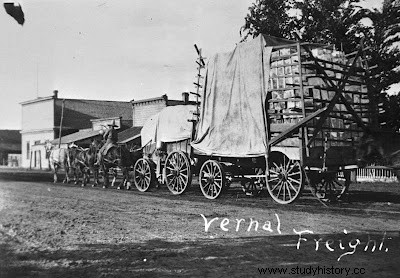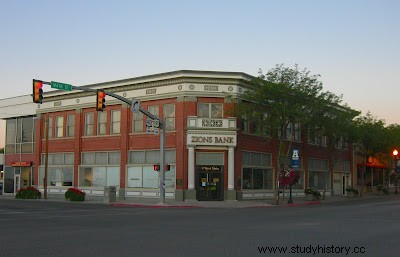I will not be the one to complain about our Post Office service, but nothing comparable to the United States Postal Service (USPS) … a century ago.
In 1913, the United States Postal Service for parcel delivery was launched. Parcel shipments became popular, stimulating the rural economy, thanks to the fact that small American farmers and merchants could sell their products anywhere in the country –door-to-door sales without leaving home – and at very competitive prices. Likewise, they could acquire medicines and other products that were difficult to access... The law was made, the cheat was made . Vernal , a small lost population in Utah, was experiencing rapid growth and William H. Coltharp , a businessman, decided that it was time for his town to have a brick building in which, in addition, a bank would be opened. The problem was that the closest brickyard was in Salt Lake City. , almost 200 km from Vernal, and traditional transport would have quadrupled the price of bricks.

William H. Coltharp, using his wits and knowing that the prices of postal packages were too low to promote the service, did the numbers to see if he paid off using the Postal Service to move the 80,000 bricks he needed to build the building; Respecting the rules of the service -the bricks had to be perfectly packed in boxes that did not exceed 50 pounds (22.5 kg)- he supposed to send 40 boxes a day... the numbers added up. But the bricks didn't travel only 200 km, but 640 km by train, with several transfers, following the line established by the Postal Service. The postmen who suffered that ordeal, raised their complaints before the General Director, Albert S. Burleson . He understood that shipments of this type could collapse the service and, although he allowed all shipments of bricks to be completed, the rules were modified, limiting shipments to 90 kg per sender and day.
It is not the intent of the United States Postal Service that buildings be shipped by mail.
William H. Coltharp had mailed a building . The bank was completed the following year and was dubbed "The Parcel Post Bank". » by the locals. The building still exists and still houses a bank.

Zions Parcel Post Bank Vernal
As I said before, fruits, butter, vegetables, chicks were sent through this service... but there is evidence that two children were also sent by Postal Service. On February 19, 1914, according to the National Postal Museum, one of the strangest packages was the one sent in Idaho, from Grangeville to Lewiston, weighing 21.8 Kg... a 4-year-old girl named May Pierstorff> . The girl's parents decided to send her to her grandparents but they thought the train ticket was very expensive and, taking advantage of a loophole in the Postal Service regulations, they paid 53 cents in stamps -stuck on her clothes- from her and they mailed it. The girl traveled on the same train but in the mail car and she was delivered to her grandparents' house by a postman named Leonard Mochel .
Once again the Postmaster General had to intervene and, now, ban sending children by mail.
(Note:the photo does not correspond to the May shipment but is representative of the article)

